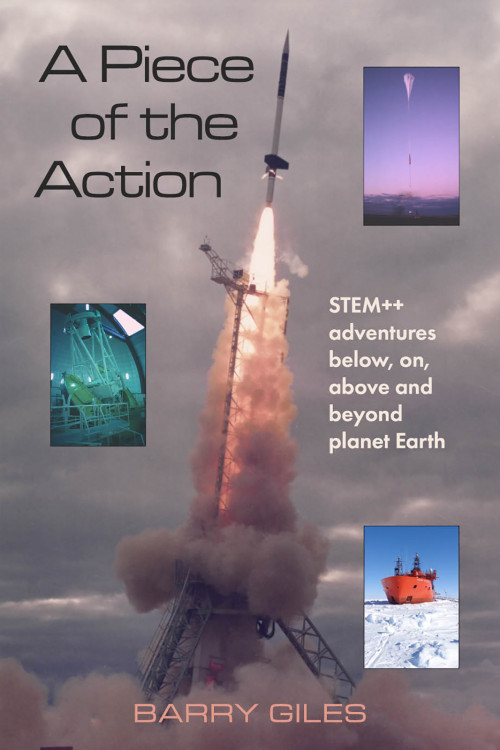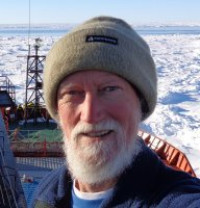
By: Barry Giles
*Available directly from our distributors, click the Available On tab below

Barry Giles was born in 1951 at Barnet in north London, UK. He grew up in East Barnet attending Church Hill Primary School, which is still there, until passing the 11 plus and going to Hatfield Tech School which no longer exists. The school buildings later became part of the adjacent Hatfield Polytechnic which eventually became Hertfordshire University. He became interested in Astronomy at the age of 10, owning and building a succession of telescopes, eventually a 11.75 inch Newtonian before going to university. His particular interest at that time was in astronomical photography, doing all the processing in his father’s shed, converted to a darkroom with a homemade enlarger.
He was in the 4th East Barnet Cub and Scout groups, and also built and flew homemade balsa wood model planes, his father’s boyhood hobby. For the four years before going to university, he had a Saturday job at J. H. Tripp Ltd, a local builder’s merchant to pay for his various hobbies. Here he gained background knowledge that was to prove invaluable many years later in Tasmania while building a holiday home as an owner builder.
After studying A levels in Physics, Maths, Computer Science and Engineering Drawing he went to Leicester University in 1970, the first member of his family to attend a university. Although briefly toying with doing architecture or computer science, the astronomy and physics option at Leicester won out. He studied pure maths and electronics for part of his first degree, but also needed to do a lot of ‘Mini-van’ car maintenance during those three years. He graduated with a first-class honours degree in 1973 and commenced a PhD at Leicester in high energy
astrophysics as part of the X-ray astronomy group within the Physics Department. Here he worked on the two Skylark rocket flights in the first chapters of this book. After a grant extension, he moved to the Astronomy department in 1977, then quite separate to Physics, and commenced doing ground-based optical and near-infrared observations on many telescopes around the world. He was awarded his PhD in 1978.
Thanks to the sudden decision by Mrs Thatcher’s Government to limit UK post docs to a maximum of 3 years financial support, regardless of the circumstances of their case, he emigrated to Australia in early 1981. Here he joined the X-ray balloon group at the University of Tasmania, and finding Tasmania to be a wonderful place to live he has endeavoured to stay there. In Tasmania he took up sailing and SCUBA diving, both activities never having appealed back in the UK climate. Over the following years he has been fortunate to dive at many locations around the world. At the university, he was engaged in the balloon flights detailed
in this book and also further ground-based telescope work within Australia.
Being employed on a contract, funding issues then dictated a move into Oceanography in 1983 when the CSIRO was moving its Marine research from Sydney to new laboratories in Hobart which created fresh job opportunities. Throughout the early 1980′s, he became increasingly concerned with environmental issues and, after marching through Hobart on protest campaigns to save the Franklin River in Tasmania from being dammed, he decided that he had better take a look at it and rafted the river at Easter in 1984. A diversion back to the university occurred through 1985-1986 for the Australian Mirrabooka satellite initiative and the 1986 balloon flight at Alice Springs. Throughout these years he continued occasional involvement in ground-based work using the university 1 m telescope.
With the eventual collapse of the Mirrabooka concept after the Challenger Shuttle disaster, he spent three years working with friends at the start-up company Protel, working on software for electronic circuit board design. Many years later Protel became Altium, an international company listed on the Australian Stock Exchange. A further two years in Hobart were spent as a self-employed software contractor, but he was not entirely out of research over these five ‘commercial’ years carrying out occasional optical projects on the university telescope. He was for a time a director of two companies. During that period, his company obtained US and Australian patents but failed to find a company willing to use and commercialise his idea. He was also employed for a time as a State Health Physicist, but his major consulting activity was to play a small but significant role in the modernisation of the then Pasminco zinc smelter located just outside Hobart. This plant uses the state’s hydroelectric power to produce around 250,000 tons of zinc a year. He developed electronics and software for the on-stream chemical analysers that made the plant more efficient, the whole programme undoubtedly being responsible for the plant still operating today.
A hankering to return to scientific research led him to move to a job with USRA at NASA GSFC in America in late 1992. Working in the USA for over four years in the PCA team on the RXTE project arguably marks the pinnacle of his technical and scientific work. However, returning to Australia for personal reasons in early 1997, he then spent many years working as a sea ice glaciologist in Hobart, linked to the University of Tasmania or the Australian Antarctic Division. Sometimes on salary, full-time or part-time, often as a self-employed AAD preferred software contractor. In the first four years after his return to Tasmania, he continued to work on aspects of RXTE data analysis and once again used the university telescope for many projects, including numerous stellar occultations by the planet Pluto.
From 2012-2015 he was a member of the X-ray astronomy LOFT mission consortium proposal to the European Space Agency which unfortunately was not selected for further study as part of their M3 and M4 rounds. More recently he has followed the NASA X-ray astronomy satellite STROBE-X mission proposal. In retirement he continued to have honorary roles at the University of Tasmania, being an associate in the Physics Department doing astrophysics, and an associate at the Institute of Marine and Antarctic Science (IMAS) finishing up glaciology-related research projects.
After his father’s death in 2003, he learned that his father had actually several times expressed the opinion, hopefully in jest, that ‘his son had never done a proper day’s work in his life’. Well, admittedly I have had a great deal of fun and travelled widely but, if you enjoy your work, is it really work? Lucky – maybe?
This book serves as a fitting testament to a life dedicated to cutting-edge scientific research. It takes readers on an absorbing global journey, involving a variety of ground-breaking STEM-based activities. Moreover, the narrative highlights the author's significant contributions across a variety of scientific fields, while also showcasing the wonder and joy that drive scientific inquiry. This book is a compelling read for anyone captivated by the marvels of science, the excitement of discovery and the quest for knowledge; it stands as a source of inspiration to those interested in STEM-centred career pathways.
We use cookies on this site to enhance your user experience and for marketing purposes.
By clicking any link on this page you are giving your consent for us to set cookies